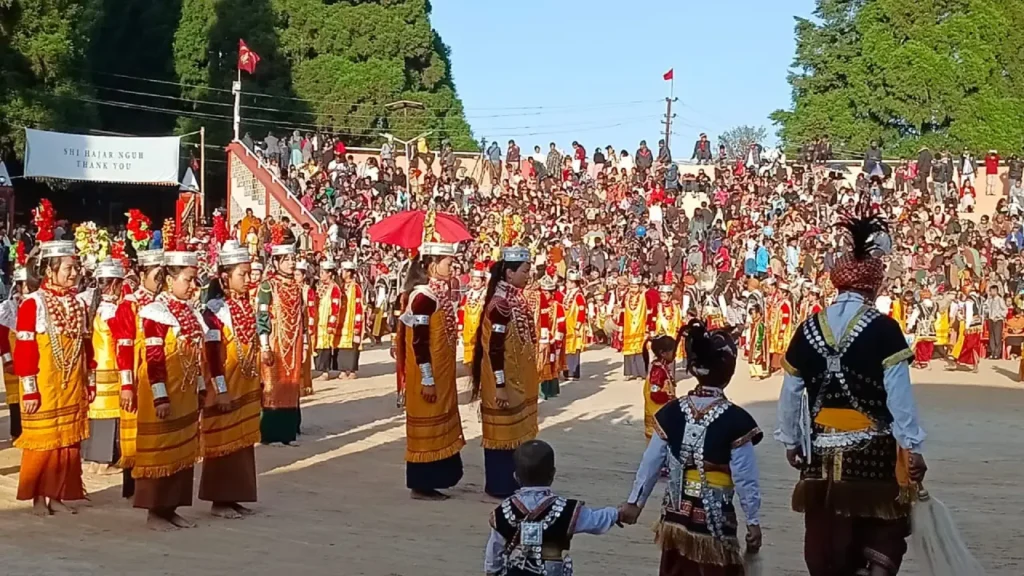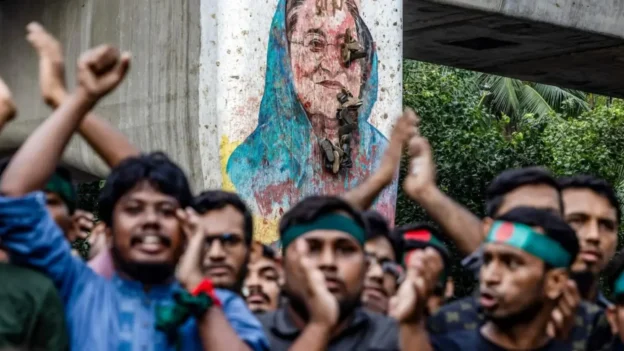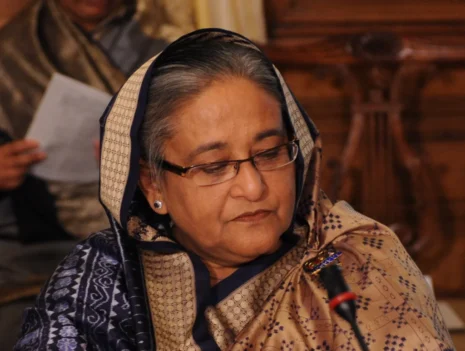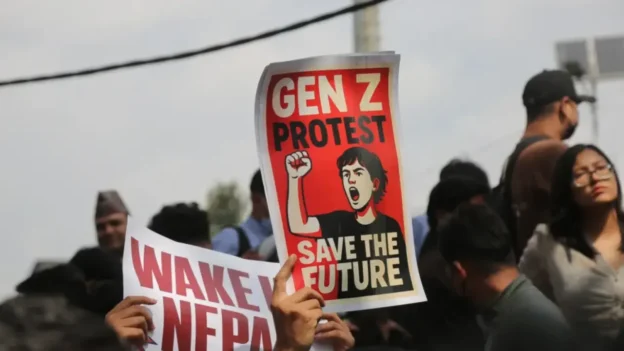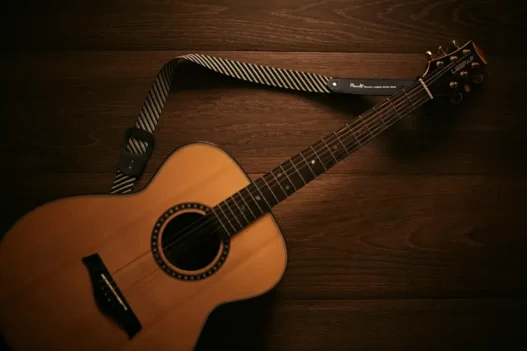Every year, just as winter light begins to settle softly over the Khasi hills, life in Hima Khyrim starts to change its pace. It is not an event that announces itself loudly. Instead, the air thickens, conversations seem to lower, and the land feels as though it is tilting slightly toward an older rhythm. People begin to return—students from Shillong’s colleges, office staff from Guwahati, professionals from Delhi’s neighbourhoods, and those who have drifted far from the hills and shaped new lives elsewhere. They arrive in Lad Smit following an instinct that feels older than memory itself, as if something deep within them knows exactly when the Hima must gather again.
They return for Nongkrem, a festival that to an outsider may look like a colourful spectacle of dancers and drums. But to the people of Hima Khyrim, Nongkrem is something far more profound—a living constitution enacted not through paper or proclamation but through shared labour, sacrifice, song, offering, and the careful choreography of responsibility. In the fabric of this month-long ceremony lies the entire logic of the Hima: its history, its fractures, its unity, and the delicate relationship between governance and sacred duty.
A Hima Born in Division, Held Together by Ritual
The beginning lies in a division. When the powerful Hima Syllong split long ago, two new realms emerged—Hima Mylliem and Hima Khyrim. Khyrim itself is made of six Raids, but during Nongkrem only five step into the sacred circle. Raid Nongkrem, though sharing the name of the festival, stays outside because of an ancient rupture remembered only through ritual—the thanglieh thangiong (meaning from ancient time they are not allowed to participate in the ritual). And so, every year, the festival proceeds with this remembered absence, its presence felt in the one Raid that stands apart.
Ritual in Khyrim is inseparable from rule. The shynshar khadar—the structure of governance—exists only when paired with niam, the obligations that bind the living to ancestors and land. A Raid’s place in the polity is confirmed through the specific duties it performs at Nongkrem. And the clearest sign that the Hima still stands united is the moment when the Blang Tyllai, the sacred goat, enters the Iingsad—the residence of the Syiem. A simple act that affirms an entire political order.
Video source : Contributed
Sacred time begins quietly. Before any music is heard, the Dhulia—drummers, messengers, memory-keepers—walk from Raid to Raid, their footsteps carrying the Kyrwoh, the formal announcement that Nongkrem is approaching. Only after they have moved across the Hima does the land begin to breathe differently. Lad Smit shifts. Families gather. And what seems at first like a village preparing for a festival reveals itself instead as a polity awakening into ritual.
Every responsibility is inherited. Those who thatch sacred structures ready their tools. Those who fashion offerings begin their work. Drummers return to tune their instruments. Others prepare the sacrificial animals or arrange to host guests. No one is learning their duties for the first time; everyone is remembering. The knowledge lives not in instruction but in repetition.
The rituals take shape
Then comes the moment that announces the true beginning of collective labour: the arrival of the traw. On the first Rynghep Day (traditional market day), villages bring the grass meant for the Iingsad roof in an order that has never been altered. Raid Rangphlang Rasong must bring the very first bundle; no one else can substitute. Raid Thaiang of Bhoi ensures the grass reaches Smit in time. Five or six days later—again on a Rynghep Day—the grass returns, signalling that it is time for the phing ia u Traw, the thatching of the sacred roof. Work begins with Raid Nongbri, specifically Phrup village, and proceeds village by village, the order preserved across generations.
Children gather under the eaves, watching their elders climb the Iingsad roof. The sound of straw being laid becomes their lesson. This is how knowledge travels in Hima Khyrim—not through textbooks, but through hands moving in inherited rhythms, through stories whispered while passing a tool, through watching one’s elder place each blade of grass exactly where it must go. By the time Smit village lays the final covering on the fifth day—always on a Rynghep Day—the Hima has fully entered its sacred month.
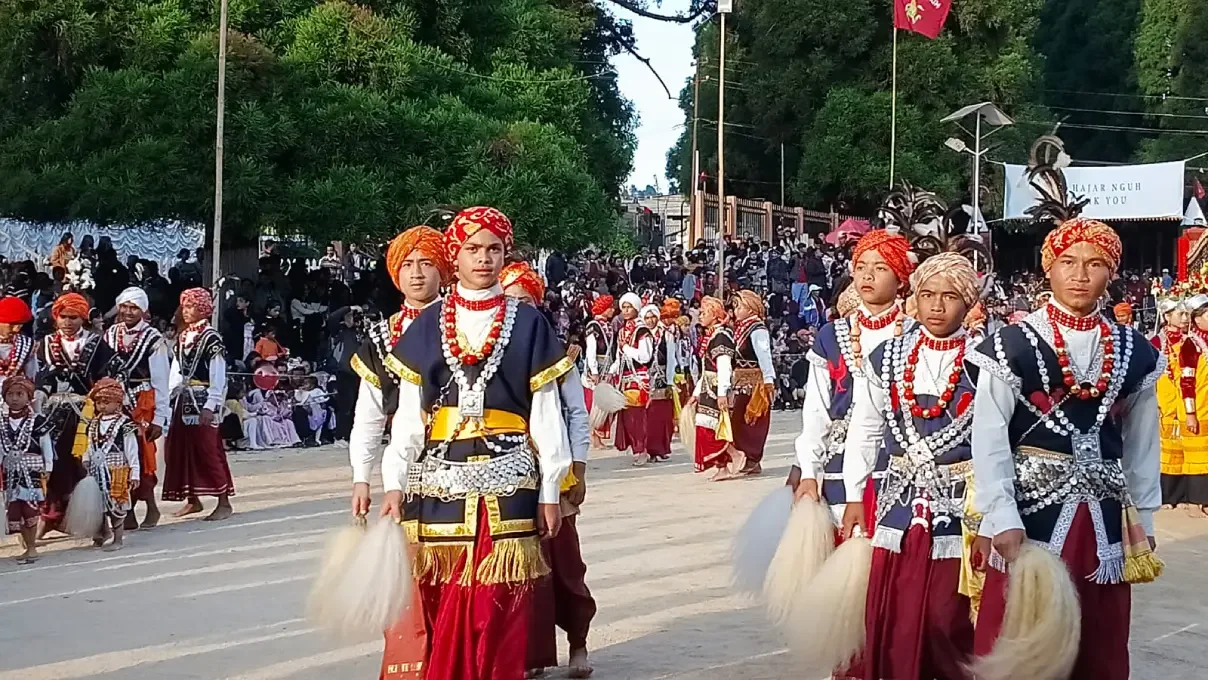
Soon, the Dhulia step into the Iingsad, their ksing, bom and padiah rolling across the courtyard like a second kind of wind. On Shillong Day, they carry the four sacred drums—the ksing, the bom, the padiah and the synsiaw—into the courtyard. For seventeen days these drums will not stop. Their beat becomes the heartbeat of the Hima, marking the ascent toward the festival’s most solemn rites.
It is on Pomtia Day that the first movements of sacred dance begin. In the tender morning light, villagers gather as the Suitdohkha rite opens the Shad Tyngkoh, the leaping dance of the Bakhraw Batri—the nobles and elders. The order is precise and unchanging: the Sohblei Rumnong, the High Priest, steps first; he is followed by Nongbri, then Mushai Mawlieh, then Lawai Nongkynrih; then comes the Syiem Rangbah, the King; and finally the Khun Syiem, the royal children. On Umni Day, the rhythm deepens. Evening draws close and a kñia khriam, a blessing sacrifice, is performed.
Day by day, the rituals accumulate, and the village becomes a theatre of ordered action—blessings offered, messages carried, spaces purified, dances performed. Here, the abstract notion of a polity becomes tangible. The Hima is not just governed; it is enacted.
Pomblang: When the hills offer their heart
Then comes Iewduh Day—the day known beyond Khyrim as the centrepiece of Nongkrem, the day of Pomblang, the great goat sacrifice. At dawn, the courtyard fills and a procession forms. The Khun Syiem, the Sohblei Rumnong, the Sohblei Mawroh Syiem, the Syiem and the Bakhraw Batri climb the hill of Lum Pomblang. Up there, where the wind tugs at ceremonial robes, the Sohblei Rumnong leads the prayers over the Blang Iewduh. The Blang Tyllai is handled with ritual precision. The Sohblei Mawroh reads its entrails—the dikhot dikhai—through the ancient divination of duwai phirat, revealing the fortunes of the Syiemship and the community for the year ahead.
Video source : Contributed
The moment the readings end, the villagers erupt into Shad Mastieh—the warrior dance of protection. Guns crack on the descent—siat suloi—to drive away malevolent forces. As the procession returns to the Iingsad, offerings restore balance.
By noon begins the Bujai Blang—the arrival of sixty-one goats, each representing not just an offering but a lineage, a duty, a village’s place in the order of the Hima. They come from all participating Raids: Nongbri; Nongkseh–Nonglong; Mawshai and its twelve Bhoi branches; Mawlieh; Lawai; and Nongkynrih. Special goats arrive from Rangphlang Rasong, Mukhim, Mukertila Massar and Nongjri—villages directly under the Syiem. Each goat steps into the courtyard as a declaration of relationship.
The next day is Lyngka, the final weaving of the ritual fabric. At dawn, in the Iingsad, the Khun Syiem and the Bakhraw Batri perform the Shad Nohkjat, a steady, stamping dance that sounds like the Hima’s heartbeat. Then the women’s Shad Kynthei unfolds, followed by the men’s Shad Shynrang, which carries on until late afternoon. Afterward, sacrificers from Raid Lawai and Nongkynrih offer the twelve Sla goats, followed by goats from all the Raids in their inherited order. A collective Risa, a rising ritual cry, breaks from the Bakhraw Batri. The Shad Mastieh (warrior dance) follows. The Syiem and the Khun Syiem bring the rites to a close. The goats are then distributed back to the Raids, completing the cycle of exchange.

Night falls gently. Under cover of darkness, the Dhulia return, carrying the kyndang Blang, the burnt remains of the sacred animals. At six in the evening, the Sniang—the pig—is sacrificed. At one in the morning on Pynsing Day, the drums strike the cool air and the Syiem prays on behalf of all twelve Sla. The following morning is Mawlong Morning. The Syiem Sad—the eldest sister of the Syiem and ritual mother of the Hima—distributes the remaining kyndang to the Bakhraw Batri of the five participating Raids.
Only then, with this last act of distribution, does the sacred month exhale. It does not end abruptly; it releases itself quietly, like a breath returning to its natural rhythm.
Children learn by seeing, not hearing
Between these ceremonies, elders teach the younger participants the logic behind every movement and offering. They explain the names of the dances, the significance of the Blang Tyllai, the genealogies that determine precedence, and the cautionary histories, such as why Raid Nongkrem remains ritually absent.
These stories are rarely codified; they live in gestures, recollections, and whispered corrections offered to a child practising a step or preparing an offering.
This transmission is intimate and embodied. Children learn not by instruction alone, but by being woven into the unfolding rituals, absorbing messages through rhythm, observation and repetition. This is why preservation is not a performance for spectators. It is the maintenance of a living, functioning social order. Nongkrem acts as a grammar of belonging, and the village itself becomes its classroom.
The final dance at Lad Smit
On the festival’s final day, Lad Smit becomes the centre of gravity for the hills. The courtyard shimmers with silk, coral and gold, as young dancers step gracefully into roles that carry centuries of meaning. Their garments are not mere decoration; they are threads connecting them to ancestors who once stood in the same circle.
Video source : Contributed
The drums settle into a resonance that feels ancestral, echoing beneath the feet of dancers and spectators alike. The Shad Nongkrem unfolds with an elegance that feels less like a performance and more like a revelation. Feet follow rhythms carved into the landscape; hands trace gestures that echo myth. The dance binds bodies to memory, memory to land, and land to community.
Even those who do not dance participate in the transmission. They watch the choreography not for entertainment, but to remember who they are and to witness how the next generation steps into the continuing story.
A tradition that lives because it teaches
When the last drumbeat fades and the final offerings are handed by the Syiem Sad, the festival leaves behind more than memories. It reaffirms a social contract that has allowed Hima Khyrim to endure through migration, modern schooling and the pressures of new economies.
Nongkrem survives because it matters—because it teaches, because it binds, because even those shaped by modern life return each year to step back into the circle, to remember, to relearn and to carry the story forward.
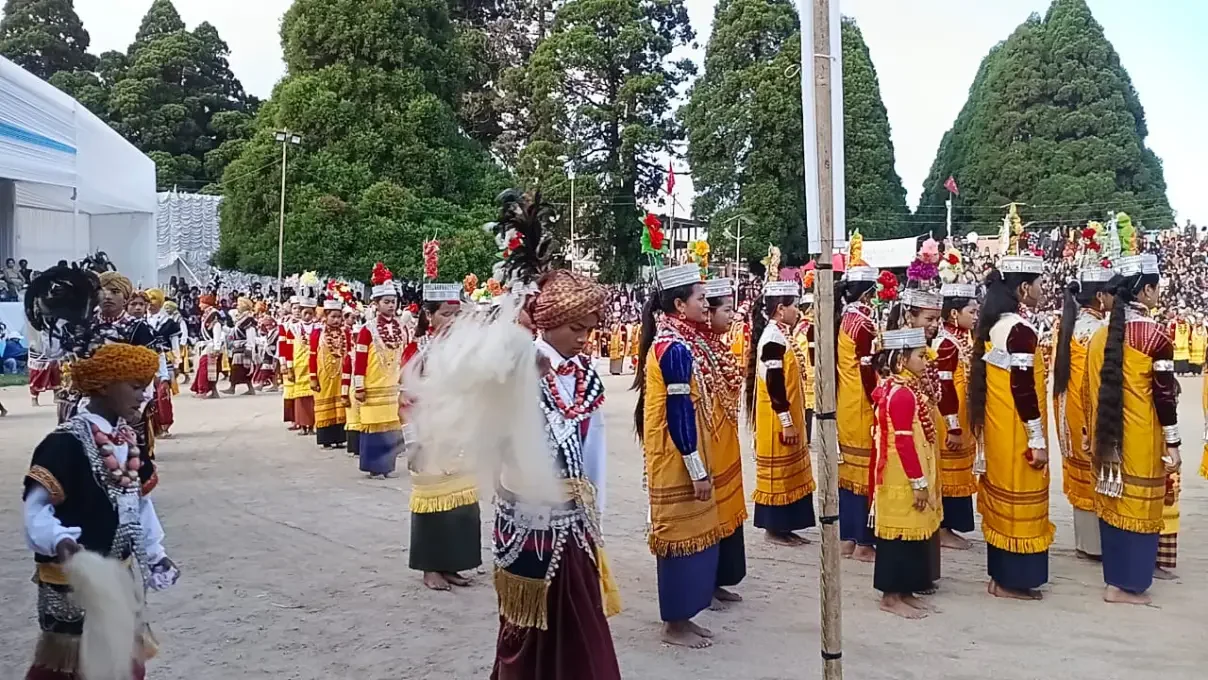
What Nongkrem leaves behind each year is not only a completed cycle of rites. It leaves behind clarity—about responsibility, ancestry, belonging, and the structure of the Hima itself. It survives not because it has remained unchanged, but because it continues to give people a reason to return. Year after year, it teaches what it means to belong—through hands that thatch roofs, feet that strike the earth in dance, voices that rise in ritual cry, and bodies that gather in the courtyard and on the hill.
Seen from the hilltop where Lum Pomblang overlooks a patchwork of forest and paddy, Nongkrem is both earthly and intangible—goats and smoke, song and prayer, politics and kinship braided into a single month of consecration. For Hima Khyrim, this remains the time when the hills offer their heart. Practised with fidelity, it will continue to be what it has always been: a way of keeping a common life possible.

